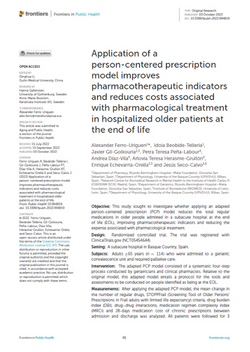The application of a person-centred prescribing model improves pharmacotherapeutic indicators and reduces costs associated with drug treatment in hospitalised elderly patients at the end of life

Front. Public Health 10:994819. doi: 10.3389/fpubh.2022.994819
This study aims to investigate whether the application of an adapted person-centred prescribing (PCP) model reduces the total number of regular medications in elderly people admitted to a sub-acute hospital at the end of life (EOL), improving pharmacotherapeutic indicators and reducing the expenditure associated with pharmacological treatment.
Due to the phenomenon of population ageing, future projections indicate a marked increase in the number of people dying in need of palliative care in the coming decades, due to multimorbidity and advanced chronicity. Linked to these phenomena of ageing and chronicity, a major public health problem arises, namely polymedication and poor therapeutic adequacy in the elderly, particularly in people with advanced frailty and at the end of life. This fact makes it necessary to implement new strategies for early identification of palliative care and to experiment with models of care centred on the person, beyond the segregated care provided by medical services, which is currently inadequate and inefficient.
This interdisciplinary work shows that the application of a person-centred prescribing model improves pharmacotherapeutic indicators in hospitalised geriatric patients at the end of life and reduces the costs associated with pharmacotherapy.
Adequacy of therapy has been found on potentially inappropriate prescriptions (STOPP Frail), anticholinergic and/or sedative burden (DBI), interactions and complexity of pharmacotherapy (MRCI), reducing the risk of drug iatrogenesis.
Future intervention models should ensure continuity between the different care transitions (hospital-primary care-residential centres), offering these new tools globally and not only in isolation.


